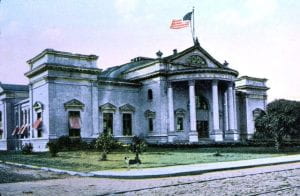
The Thompson Auditorium in 1910, the location of the Charleston Museum as Miss Bragg knew it.
The Charleston Museum was founded in 1773, right in the midst of the American Revolutionary fervor. America’s self-proclaimed “first museum” opened to the public in 1824, and years later hired the first ever woman public museum director; Laura Bragg, hired in 1920. Laura Bragg is the inspiration behind the character Miss Wragg in Harlan Greene’s Why We Never Danced the Charleston, a slim but powerful novel aout gay men in 1920’s Charleston. The Charleston Museum is featured in the work as the place of employment for the main (unnamed) character and the novel’s doomed lovers, Hirsch Hess and Ned Grimke. Today the Charleston Museum focuses on Southern history, with permanent exhibitions housing textiles and weaponry, and has been in its current building since the 1970s, and was therefore in a different location when Laura Bragg and her “boys” occupied its offices in the 1920s.
Why We Never Danced the Charleston’s back cover proclaims “the time, the 1920s, when old ladies dream of the past and a strange new dance, ‘the Charleston,’ is seducing the youth of the city,” as the major setting of the novel, and Charleston in the 1920s was certainly a time of reflection and advancement. Though the novel’s storyteller is placed in 1973, much of the novel’s events, and the plot involving the Charleston Museum, takes place in the 1920s. According to the article “The Charleston in the 1920s” by Albert Haim, the dance known as the Charleston was introduced in the Broadway show Runnin’ Wild in 1923, making the novel’s events, where many are shocked and outraged by the dance, occupy the latter part of the decade. This is the high period of the Charleston Renaissance, where visual artists and writers alike are working to glorify the past and present architecture of their Southern city, all while ignoring the deep tensions that divide and contribute to the evolution of Charleston. It’s a time for preserving and honoring the past (in fact, the nation’s first preservation society, the Society for the Preservation of Old Dwellings, was established in Charleston in 1920 by Susan Pringle Frost) while struggling to embrace the modern, symbolized by the “shocking” dance sweeping the nation.
The importance of the Charleston Museum to the novel’s events ties into the theme of preserving the past that is very evident in the novel’s storytelling and the author’s intentions. On the surface level, the Charleston Museum is the place of employment for most of the major characters in the novel, where the narrator and Hirsh already work for Miss. Wragg and Ned is hired about halfway through the book, his artistic prowess employed in making dioramas for each of the museum’s exhibits. The narrator describes the museum as “like a living thing,” a source of passion for Miss Wragg and a community for Ned unlike many he has ever known before (64). It was an excursion for the museum that led to the characters witnessing the dead bodies of the interracial couple, a stark warning to their possible futures as gay men in a heteronormative society. Miss Bragg and her work at the museum was also a major source of inspiration for Greene in writing the novel, the text’s signature events arising from Miss Bragg’s comment to him that “Ned did not kill himself” (125).
The Charleston Museum has undergone a lot of changes since the 1920s. Most prominently, the location is different than before, the museum once being housed by the Library Society, then occupying the second floor of a building on the College of Charleston’s campus, then moving to the Thompson Auditorium in 1907, which would be the location known to the characters and Laura Bragg. Its new location, 360 Meeting St, was not built until the 1970s, and is the location I, and anyone who comes to Charleston, visit during the modern era. We are miles past the Jim Crow era as well, and Miss Bragg’s vision of an integrated museum is fully recognized in modern society, as there are no restrictions on who can and cannot enter the museum or use its services.

My visit to the Charleston Museum in 2022!
Other sources used: Stephanie E. Yuhl’s A Golden Haze of Memory, The Charleston Museum historical article by Peta Stamper, postcard and information on The Old Charleston Museum
